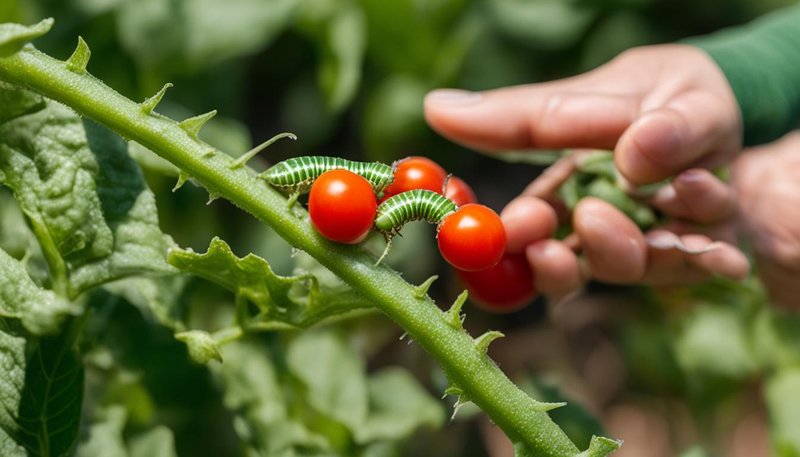
Think of hornworms as those uninvited party crashers at your garden gathering. They might be intriguing at first glance, but ultimately, they’re not good for your plants. In this article, I’ll share practical tips for handpicking hornworms effectively. Plus, I’ll help you navigate the delicate balance of pest control without damaging your plants—kind of like getting rid of that awkward guest without causing a scene.
If you notice your plants suffering, especially tomatoes or peppers, it can feel overwhelming. But with the right technique and tools, you can manage this situation easily. Let’s dive in!
Understanding Hornworms: The Basics
Before we tackle the how-to’s of handpicking, it’s helpful to know a bit more about hornworms. These caterpillars can grow up to 4 inches long and often have a distinctive horn on their rear end. They’re mostly the larvae of the tobacco or tomato hornworm moth, and they love to feast on your garden’s lush foliage. When you spot one, it’s key to act swiftly, as they can strip your plants bare in no time.
You’ll typically find hornworms hiding among the leaves, blending in with the foliage. They’re more active during the day, which means you might catch them in the act. But, you might be wondering, why should you care? Well, these little munchers can significantly damage your plants, quickly leading to stunted growth or even death if left unchecked.
So, if you’re invested in your garden and want to keep it thriving, understanding these pests is a crucial first step. Just like any good gardener, knowing your enemy can make all the difference.
When to Look for Hornworms
Timing is everything when it comes to handpicking hornworms. You want to make sure you’re out there on the lookout before they can wreak havoc. Typically, late spring and summer are peak seasons for these pests. Early mornings or late afternoons can be the best times to spot them, as they tend to hide during the hottest parts of the day.
Here’s the thing: often, hornworms will start out small and blend in beautifully with the green foliage. Before you know it, a few days can turn a tiny caterpillar into a munching monster. Regular checks on your plants can help catch these little guys early on.
You can also keep an eye out for specific signs of hornworm activity:
- Chewed leaves: You might notice leaves that are suddenly missing sections or have ragged edges.
- Excrement: Look for small, dark droppings on the leaves; this can signal their presence.
- Wilted plants: If your plants appear weak or droopy, they could be under attack.
Being proactive and keeping a close watch can save you a lot of headaches down the line.
Gathering Your Tools
Before you head out to the garden, it’s a good idea to gather a few handy tools, which can make the handpicking process smoother. The best part? These tools aren’t complicated. Here’s what you’ll need:
- Gloves: Protect your hands from dirt and any potential chemicals.
- Container: Having a small bucket or bag to collect hornworms makes the process easier.
- Garden shears (optional): If you want to cut off damaged leaves while you search, these can come in handy.
Honestly, you don’t need a complete toolbox to get the job done, but having these basic items can minimize the mess and keep your hands clean.
Handpicking Techniques
Now that you’re equipped, let’s discuss how to effectively handpick hornworms. The key here is to be gentle and observant. Here’s a straightforward method to make your task easier:
1. **Visual Inspection:** Start by thoroughly examining your plants, particularly the undersides of leaves where hornworms often hide. Look for their distinctive green color.
2. **Gentle Removal:** Once you spot a hornworm, wear your gloves, and gently grasp it by its body. They can be a bit squirmy, but with a firm grip, you’ll be able to remove them without damaging your plants.
3. **Place in Container:** Transfer the hornworm to your collection container. If you have a lot of them, you can even relocate them far from your garden or find a beneficial predator that will help keep their population under control.
This method is straightforward and doesn’t require any fancy gadgets or sprays that could harm your plants or nearby beneficial insects.
Preventing Hornworm Infestations
After successfully handpicking, you might be wondering how to prevent these pests from returning. Prevention is always a great strategy, and there are several steps you can take to keep your garden safe:
- Regular Monitoring: Keep checking your plants routinely; this will help you catch any new hornworms early.
- Encourage Beneficial Insects: Sometimes the best defense is a strong offense. Ladybugs and parasitic wasps are natural predators of hornworms.
- Crop Rotation: Changing the location of your plants each season can disrupt the life cycle of hornworms.
By implementing these preventive measures, you can significantly reduce the chances of an infestation and keep your garden thriving.
Safe Alternatives for Pest Control
If handpicking sounds daunting, or if the infestation is too large to manage alone, there are alternative pest control measures. Here are a few options that won’t harm your plants or other beneficial wildlife:
1. **Organic Insecticides:** Products with ingredients like Bacillus thuringiensis (Bt) target hornworms specifically. They’re safe for plants, pets, and humans.
2. **Neem Oil:** This natural pesticide disrupts the life cycle of pests and is safe to use on vegetables. Just mix it with water and spray it on affected areas.
3. **Companion Planting:** Some plants like marigolds deter pests. Planting them alongside your veggies can help keep hornworms at bay naturally.
With these alternatives in your back pocket, you’re well-equipped to fight off hornworms without harming your garden.
As you can see, handpicking hornworms isn’t just about getting rid of those pesky pests; it’s also about nurturing your garden and ensuring healthy growth. With a little observation and the right tools, you can protect your plants and enjoy the fruits of your labor.
So take a stroll through your garden often, and don’t hesitate to get your hands a little dirty. After all, gardening is about connecting with nature and nurturing your plants. By using the techniques we discussed, you’ll not only keep hornworms at bay but also foster a thriving environment for your vegetables to flourish. Happy gardening!

